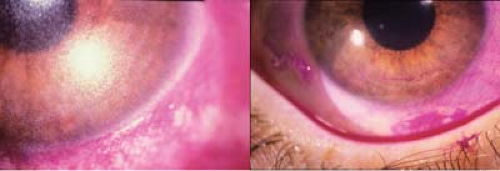Vitamins
Alex V. Levin
Thomas W. Wilson
Elise Héon
Vitamins, minerals, and metals are critical for the maintenance of ocular health and are required for the visual process. Many imbalances of these substances can lead to significant vision loss from ocular surface disease, cataract, retinal dysfunction, and optic neuropathies. Vitamin deficiencies can be the result of a decreased intake (starvation, alcoholism, and poor diet) or decreased absorption (cystic fibrosis and inflammatory bowel diseases). Decreased vitamins can also be secondary to abetalipoprotein- emia. Hypervitaminosis can be secondary to consumption of foods high in vitamins (increased vitamin A from ingestion of polar bear liver) or supplemental oral intake. Increased levels of vitamin A have been associated with pseudotumor cerebri and loss of vision secondary to increased intracranial pressure. Decreased levels of vitamin D have been shown to cause corneal band keratopathy.
Poor nutrition is a common cause of vision loss in the third-world countries. Low levels of vitamin B12 and folate can cause significant dysfunction of the optic nerve with irreversible loss of color vision, central vision, and visual field. Vision loss can also occur from low levels of vitamin A. Vitamin A is critical for the functioning of rods and cone photoreceptors.
Supplemental vitamin intake has been recommended for several ocular diseases. For example, supplemental vitamin E, an antioxidant, is commonly administered to premature infants to theoretically decrease free radical oxygen. The effects of vitamin E on retinopathy of prematurity (ROP) have been studied, and the results do not significantly show a harmful or beneficial effect of vitamin E on the severity or progression of ROP.
 Figure 22.1 Vitamin A Deficiency—Xerophthalmia Vitamin A is necessary for growth and proper functioning of epithelium and mucous membranes throughout the body. Deficiency leads to squamous metaplasia, keratinization of mucous-secreting epithelium, thinning of hair, and dry, scaling skin. Ocular changes resulting from vitamin A deficiency are termed xerophthalmia and reflect a conjunctival goblet cell deficiency with potential secondary inflammatory response. Devitalized epithelium will stain with rose Bengal (right image). The World Health Organization’s recommendation for the prevention of xerophthalmia in children less than 12 months of age is 100,000 IU vitamin A every 4 to 6 months and for children more than 12 months of age is 200,000 IU vitamin A every 4 to 6 months. In the developed world this is usually achieved through daily dietary intake without supplementation. (The authors are grateful for the contributions of Dr. Christopher Cessna to this legend.)
Stay updated, free articles. Join our Telegram channel
Full access? Get Clinical Tree
 Get Clinical Tree app for offline access
Get Clinical Tree app for offline access

|